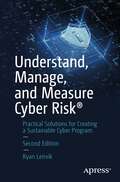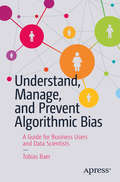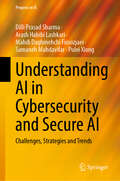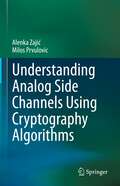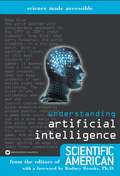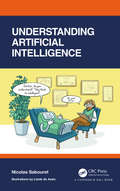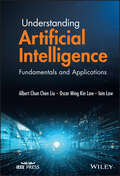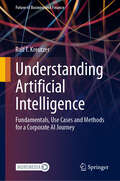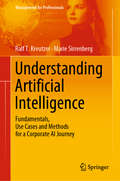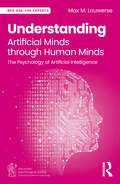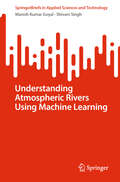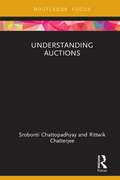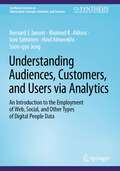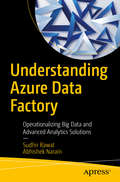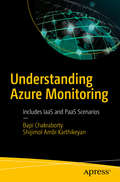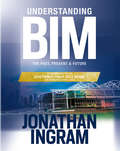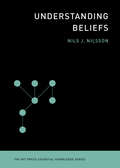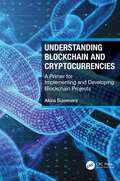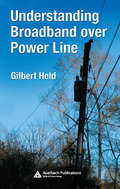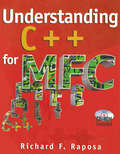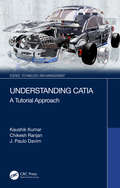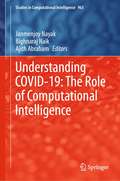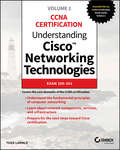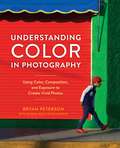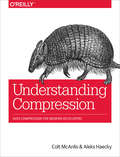- Table View
- List View
Understand, Manage, and Measure Cyber Risk: Practical Solutions for Creating a Sustainable Cyber Program
by Ryan LeirvikWhen it comes to managing cybersecurity in an organization, most organizations tussle with basic foundational components. This practitioner’s guide lays down those foundational components, with real client examples and pitfalls to avoid. A plethora of cybersecurity management resources are available—many with sound advice, management approaches, and technical solutions—but few with one common theme that pulls together management and technology, with a focus on executive oversight. Author Ryan Leirvik helps solve these common problems by providing a clear, easy-to-understand, and easy-to-deploy "playbook" for a cyber risk management approach applicable to your entire organization.This second edition provides tools and methods in a straight-forward, practical manner to guide the management of a cybersecurity program. Expanded sections include the critical integration of cyber risk management into enterprise risk management, the important connection between a Software Bill of Materials and Third-party Risk Programs, and additional "how to" tools and material for mapping frameworks to controls.Praise for Understand, Manage, and Measure Cyber RiskWhat lies ahead of you in the pages of this book? Clean practicality, not something that just looks good on paper—brittle and impractical when exposed to the real world. I prize flexibility and simplicity instead of attempting to have answers for everything and the rigidity that results. This simplicity is what I find valuable within Ryan's book. Tim Collyer, Motorola SolutionsIt seems that I have found a kindred spirit—a builder who has worked with a wide variety of client CISOs on their programs, gaining a deep understanding of how a successful and sustainable program should be constructed. Ryan's cyber work in the US Department of Defense, his McKinsey & Company consulting, and his advisory and survey work with IANS give him a unique global view of our shared passion. Nicholas J. Mankovich, PhD, MS, CISPPWho This Book Is For CISOs, CROs, CIOs, directors of risk management, and anyone struggling to pull together frameworks or basic metrics to quantify uncertainty and address risk
Understand, Manage, and Prevent Algorithmic Bias: A Guide for Business Users and Data Scientists
by Tobias BaerAre algorithms friend or foe?The human mind is evolutionarily designed to take shortcuts in order to survive. We jump to conclusions because our brains want to keep us safe. A majority of our biases work in our favor, such as when we feel a car speeding in our direction is dangerous and we instantly move, or when we decide not take a bite of food that appears to have gone bad. However, inherent bias negatively affects work environments and the decision-making surrounding our communities. While the creation of algorithms and machine learning attempts to eliminate bias, they are, after all, created by human beings, and thus are susceptible to what we call algorithmic bias.In Understand, Manage, and Prevent Algorithmic Bias, author Tobias Baer helps you understand where algorithmic bias comes from, how to manage it as a business user or regulator, and how data science can prevent bias from entering statistical algorithms. Baer expertly addresses some of the 100+ varieties of natural bias such as confirmation bias, stability bias, pattern-recognition bias, and many others. Algorithmic bias mirrors—and originates in—these human tendencies. Baer dives into topics as diverse as anomaly detection, hybrid model structures, and self-improving machine learning. While most writings on algorithmic bias focus on the dangers, the core of this positive, fun book points toward a path where bias is kept at bay and even eliminated. You’ll come away with managerial techniques to develop unbiased algorithms, the ability to detect bias more quickly, and knowledge to create unbiased data. Understand, Manage, and Prevent Algorithmic Bias is an innovative, timely, and important book that belongs on your shelf. Whether you are a seasoned business executive, a data scientist, or simply an enthusiast, now is a crucial time to be educated about the impact of algorithmic bias on society and take an active role in fighting bias.What You'll LearnStudy the many sources of algorithmic bias, including cognitive biases in the real world, biased data, and statistical artifactUnderstand the risks of algorithmic biases, how to detect them, and managerial techniques to prevent or manage themAppreciate how machine learning both introduces new sources of algorithmic bias and can be a part of a solutionBe familiar with specific statistical techniques a data scientist can use to detect and overcome algorithmic biasWho This Book is ForBusiness executives of companies using algorithms in daily operations; data scientists (from students to seasoned practitioners) developing algorithms; compliance officials concerned about algorithmic bias; politicians, journalists, and philosophers thinking about algorithmic bias in terms of its impact on society and possible regulatory responses; and consumers concerned about how they might be affected by algorithmic bias
Understanding AI in Cybersecurity and Secure AI: Challenges, Strategies and Trends (Progress in IS)
by Arash Habibi Lashkari Dilli Prasad Sharma Mahdi Daghmehchi Firoozjaei Samaneh Mahdavifar Pulei XiongThis book presents an overview of the emerging topics in Artificial Intelligence (AI) and cybersecurity and addresses the latest AI models that could be potentially applied to a range of cybersecurity areas. Furthermore, it provides different techniques of how to make the AI algorithms secure from adversarial attacks. The book presents the cyber threat landscape and explains the various spectrums of AI and the applications and limitations of AI in cybersecurity. Moreover, it explores the applications and limitations of secure AI. The authors discuss the three categories of machine learning (ML) models and reviews cutting-edge recent Deep Learning (DL) models. Furthermore, the book provides a general AI framework in security as well as different modules of the framework; similarly, chapter four proposes a general framework for secure AI. It explains different aspects of network security including malware and attacks. The book also includes a comprehensive study of various scopes of application security; categorised into three groups of smartphone, web application, and desktop application and delves into the concepts of cloud security. The authors discuss state-of-the-art Internet of Things (IoT) security and describe various challenges of AI for cybersecurity, such as data diversity, model customising, explainability, and time complexity and includes some future work. They provide a comprehensive understanding of adversarial machine learning including the up-to-date adversarial attacks and defences. The book finishes off with a discussion of the challenges and future work in secure AI. Overall, this book covers applications of AI models to various fields of cybersecurity and appeals not only to an scholarly audience but also to professionals wanting to learn more about the new developments in these areas.
Understanding Analog Side Channels Using Cryptography Algorithms
by Alenka Zajić Milos PrvulovicThis book offers the latest research results on analog side channels and their usage in cybersecurity. It demystifies analog side channels and demonstrates new use cases for them. The first part of this book discusses how analog side channels are generated, the physics behind it, the modeling and measurements of analog side channels, and their analogies to wireless communication systems. The second part of this book introduces new applications that benefit from leveraging side channels. In addition to breaking cryptography algorithms, it demonstrates how analog side channels can be used for malware detection, program profiling, hardware profiling, hardware/software attestation, hardware identification, and hardware Trojan detection.Side channel is one of the methods for obtaining information about program execution. Traditionally, they are used in computer science to extract information about a key in cryptographic algorithms. What makes them different from other ways of extracting information about program execution is that side channels rely on how a system implements program execution, rather than what the program’s algorithm specifies. Analog side channels are particularly powerful because they are not easy to suppress or detect that someone is collecting information from the system. Although they are very powerful tools, they are poorly understood.This book targets advanced level students in computer science and electrical engineering as a textbook. Researchers and professionals working with analog side channels, how to model them, measure them, improve signal to noise ratio, and invent new signal processing techniques can also use this book. Computer scientists and engineers who want to learn new applications of side channels to improve system security, new techniques for breaking cryptography keys, new techniques for attestation, and new techniques for hardware Trojan detection will also want to purchase this book.
Understanding Artificial Intelligence
by Editors of Scientific AmericanEssays from the world's experts in AI.
Understanding Artificial Intelligence
by Nicolas SabouretArtificial Intelligence (AI) fascinates, challenges and disturbs us. There are many voices in society that predict drastic changes that may come as a consequence of AI – a possible apocalypse or Eden on earth. However, only a few people truly understand what AI is, what it can do and what its limitations are. Understanding Artificial Intelligence explains, through a straightforward narrative and amusing illustrations, how AI works. It is written for a non-specialist reader, adult or adolescent, who is interested in AI but is missing the key to understanding how it works. The author demystifies the creation of the so-called "intelligent" machine and explains the different methods that are used in AI. It presents new possibilities offered by algorithms and the difficulties that researchers, engineers and users face when building and using such algorithms. Each chapter allows the reader to discover a new aspect of AI and to become fully aware of the possibilities offered by this rich field.
Understanding Artificial Intelligence: Fundamentals and Applications
by Albert Chun-Chen Liu Oscar Ming Law Iain LawUnderstanding Artificial Intelligence Provides students across majors with a clear and accessible overview of new artificial intelligence technologies and applications Artificial intelligence (AI) is broadly defined as computers programmed to simulate the cognitive functions of the human mind. In combination with the Neural Network (NN), Big Data (BD), and the Internet of Things (IoT), artificial intelligence has transformed everyday life: self-driving cars, delivery drones, digital assistants, facial recognition devices, autonomous vacuum cleaners, and mobile navigation apps all rely on AI to perform tasks. With the rise of artificial intelligence, the job market of the near future will be radically different???many jobs will disappear, yet new jobs and opportunities will emerge. Understanding Artificial Intelligence: Fundamentals and Applications covers the fundamental concepts and key technologies of AI while exploring its impact on the future of work. Requiring no previous background in artificial intelligence, this easy-to-understand textbook addresses AI challenges in healthcare, finance, retail, manufacturing, agriculture, government, and smart city development. Each chapter includes simple computer laboratories to teach students how to develop artificial intelligence applications and integrate software and hardware for robotic development. In addition, this text: Focuses on artificial intelligence applications in different industries and sectors Traces the history of neural networks and explains popular neural network architectures Covers AI technologies, such as Machine Vision (MV), Natural Language Processing (NLP), and Unmanned Aerial Vehicles (UAV) Describes various artificial intelligence computational platforms, including Google Tensor Processing Unit (TPU) and Kneron Neural Processing Unit (NPU) Highlights the development of new artificial intelligence hardware and architectures Understanding Artificial Intelligence: Fundamentals and Applications is an excellent textbook for undergraduates in business, humanities, the arts, science, healthcare, engineering, and many other disciplines. It is also an invaluable guide for working professionals wanting to learn about the ways AI is changing their particular field.
Understanding Artificial Intelligence: Fundamentals, Use Cases and Methods for a Corporate AI Journey (Future of Business and Finance)
by Ralf T. KreutzerThis book on Artificial Intelligence (AI) explores its transformative potential for individuals and businesses. It covers AI basics and its applications across various industries, presenting AI as a foundational technology that will impact all aspects of life and the economy. The author emphasizes the need for responsible AI usage and introduces the concept of the "AI Journey" for businesses to leverage AI's potential. The second edition is updated with recent developments, including large language models like Aleph Alpha and ChatGPT, generative AI, affective computing, and ethical considerations. It also discusses open-source solutions, legal frameworks, and practical use cases. Recommended for leaders, decision-makers, students, professors, and anyone interested in understanding AI's future impact.
Understanding Artificial Intelligence: Fundamentals, Use Cases and Methods for a Corporate AI Journey (Management for Professionals)
by Ralf T. Kreutzer Marie SirrenbergArtificial Intelligence (AI) will change the lives of people and businesses more fundamentally than many people can even imagine today. This book illustrates the importance of AI in an era of digitalization. It introduces the foundations of AI and explains its benefits and challenges for companies and entire industries. In this regard, AI is approached not just as yet another technology, but as a fundamental innovation, which will spread into all areas of the economy and life, and will disrupt business processes and business models in the years to come. In turn, the book assesses the potential that AI holds, and clarifies the framework that is necessary for pursuing a responsible approach to AI. In a series of best-practice cases, the book subsequently highlights a broad range of sectors and industries, from production to services; from customer service to marketing and sales; and in industries like retail, health care, energy, transportation and many more. In closing, a dedicated chapter outlines a roadmap for a specific corporate AI journey.No one can ignore intensive work with AI today - neither as a private person, let alone as a top performer in companies. This book offers a thorough, carefully crafted, and easy to understand entry into the field of AI. The central terms used in the AI context are given a very good explanation. In addition, a number of cases show what AI can do today and where the journey is heading. An important book that you should not miss!Professor Dr. Harley KrohmerUniversity of Bern"Inspiring, thought provoking and comprehensive, this book is wittingly designed to be a catalyst for your individual and corporate AI journey.”Avo Schönbohm, Professor at the Berlin School of Economics and Law, Enterprise Game Designer at LUDEO and Business Punk
Understanding Artificial Minds through Human Minds: The Psychology of Artificial Intelligence (BPS Ask The Experts in Psychology Series)
by Max M. LouwerseUnderstanding Artificial Minds through Human Minds: The Psychology of Artificial Intelligence provides an accessible introduction into artificial intelligence through the lens of psychology.What are the similarities and differences between concepts known in psychology with regards to the brain, mind and behaviour, and how do they compare with their computational counterparts? With many rapid developments it becomes easy to lose sight of the very essentials of artificial intelligence. Beginning with an introduction to the relationship between AI and human minds, this popular science book goes on to discuss complex issues, including how humans and AI think, learn, remember, and use language. It doesn't shy away from complicated issues of human and AI collaboration or ethics, and provides great insight into the future of AI and applications for our society.Answering all the questions you've been too afraid to ask, Understanding Artificial Minds through Human Minds is a must-read for anyone wanting to understand more about the greatest technological advancement of a generation, and the impact for human psychology.
Understanding Atmospheric Rivers Using Machine Learning (SpringerBriefs in Applied Sciences and Technology)
by Manish Kumar Goyal Shivam SinghThis book delves into the characterization, impacts, drivers, and predictability of atmospheric rivers (AR). It begins with the historical background and mechanisms governing AR formation, giving insights into the global and regional perspectives of ARs, observing their varying manifestations across different geographical contexts. The book explores the key characteristics of ARs, from their frequency and duration to intensity, unraveling the intricate relationship between atmospheric rivers and precipitation. The book also focus on the intersection of ARs with large-scale climate oscillations, such as El Niño and La Niña events, the North Atlantic Oscillation (NAO), and the Pacific Decadal Oscillation (PDO). The chapters help understand how these climate phenomena influence AR behavior, offering a nuanced perspective on climate modeling and prediction. The book also covers artificial intelligence (AI) applications, from pattern recognition to prediction modeling and early warning systems. A case study on AR prediction using deep learning models exemplifies the practical applications of AI in this domain. The book culminates by underscoring the interdisciplinary nature of AR research and the synergy between atmospheric science, climatology, and artificial intelligence
Understanding Auctions: Understanding Auctions In Real Life (Routledge Focus on Management and Society)
by Srobonti Chattopadhyay Rittwik ChatterjeeThe book elaborates the basic principles of Auction Theory in a non-technical language so as to make them easily accessible to even those not trained in the discipline. Auctions as allocation mechanisms have been in use across the world since antiquity and are still employed in different countries for purchase and sales of a wide range of objects, both by governments and by private agents. Auction has gained popularity over other allocation mechanisms since the rules of auctions are very precise, involve much less subjective judgements compared to other alternative allocation mechanisms and lead to a more efficient process of discovering the true willingness of the buyers to pay. Moreover, the principles of Auction Theory are used in other contexts, for example in designing contests, or in controlling emission levels through allocation of permits and licenses.
Understanding Audiences, Customers, and Users via Analytics: An Introduction to the Employment of Web, Social, and Other Types of Digital People Data (Synthesis Lectures on Information Concepts, Retrieval, and Services)
by Bernard J. Jansen Joni Salminen Kholoud K. Aldous Hind Almerekhi Soon-gyo JungThis book presents the foundations of using analytics from the laboratory, social media platforms, and the web. The authors cover key topics including analytics strategy, data gathering approaches, data preprocessing, data quality assessment, analytical methods, tools, and validation methods. The book includes chapters explaining web analytics, social media analytics, and how to create an analytics strategy. The authors also cover on data sources, such as online surveys, crowdsourcing, eye tracking, mouse tracking, social media APIs, search logs, and analytics triangulation. The book also discusses analytical tools for social media analytics, search analytics, persona analytics, user studies, and website analytics. The authors conclude by examining the validity of online analytics.
Understanding Azure Data Factory: Operationalizing Big Data And Advanced Analytics Solutions
by Sudhir Rawat Abhishek NarainImprove your analytics and data platform to solve major challenges, including operationalizing big data and advanced analytics workloads on Azure. You will learn how to monitor complex pipelines, set alerts, and extend your organization's custom monitoring requirements.This book starts with an overview of the Azure Data Factory as a hybrid ETL/ELT orchestration service on Azure. The book then dives into data movement and the connectivity capability of Azure Data Factory. You will learn about the support for hybrid data integration from disparate sources such as on-premise, cloud, or from SaaS applications. Detailed guidance is provided on how to transform data and on control flow. Demonstration of operationalizing the pipelines and ETL with SSIS is included. You will know how to leverage Azure Data Factory to run existing SSIS packages. As you advance through the book, you will wrap up by learning how to create a single pane for end-to-end monitoring, which is a key skill in building advanced analytics and big data pipelines. What You'll LearnUnderstand data integration on Azure cloudBuild and operationalize an ADF pipelineModernize a data warehouseBe aware of performance and security considerations while moving data Who This Book Is ForData engineers and big data developers. ETL (extract, transform, load) developers also will find the book useful in demonstrating various operations.
Understanding Azure Monitoring: Includes IaaS and PaaS Scenarios
by Bapi Chakraborty Shijimol Ambi KarthikeyanExplore the architectural constructs of Azure monitoring capabilities and learn various design and implementation aspects for complex use cases. This book covers the different scenarios in a modern-day multi-cloud enterprise and the tools available in Azure for monitoring and securing these environments. Understanding Azure Monitoring starts by discussing the rapid changes happening in the cloud and the challenges faced by cloud architects. You will then look at the basics of Azure monitoring and the available tools, including service level agreements (SLAs), auditing, and security. Next, you will learn how to select the best tools for monitoring, operational strategy, and integration with on-premises SIEM systems. You’ll work through some scenario-based examples to monitor the workload and respond to failures. Here, you will monitor a simple web application on Azure, a multi-region web application, and applications that include PaaS and IaaS services. Towards the end of the book, you will explore monitoring in DevOps and see why it is important to be aware of continuous changes. What You Will LearnWork with Azure IaaS and PaaS resources and monitoring and diagnostics capabilitiesDiscover how the operational landscape changes on AzureLook at cloud-only and on-premises hybrid integrationStudy architectural constructs for design and implementationWho This Book Is ForInfrastructure and solution architects who want to integrate Azure-based monitoring solutions in a cloud native or hybrid-cloud architecture.
Understanding BIM: The Past, Present and Future
by Jonathan IngramUnderstanding BIM presents the story of Building Information Modelling, an ever evolving and disruptive technology that has transformed the methodologies of the global construction industry. Written by the 2016 Prince Philip Gold Medal winner, Jonathan Ingram, it provides an in-depth understanding of BIM technologies, the business and organizational issues associated with its implementation, and the profound advantages its effective use can provide to a project team. Ingram, who pioneered the system heralding the BIM revolution, provides unrivalled access to case material and relevance to the current generation of BIM masters. With hundreds of colour images and illustrations showing the breadth and power of BIM, the book covers: The history of BIM What BIM is in technical and practical terms How it changes the day to day working environment Why we need BIM and what problems it can solve Where BIM is headed, particularly with regards to AI, AR, VR and voice recognition International case studies from a range of disciplines including: architecture, construction management, and retail Professionals and students in any field where the inter-disciplinary aspects of BIM are in operation will benefit from Ingram’s insights. This book is an authoritative account of and reference on BIM for anyone wanting to understand its history, theory, application and potential future developments.
Understanding Beliefs (The MIT Press Essential Knowledge Series)
by Nils J. NilssonWhat beliefs are, what they do for us, how we come to hold them, and how to evaluate them. Our beliefs constitute a large part of our knowledge of the world. We have beliefs about objects, about culture, about the past, and about the future. We have beliefs about other people, and we believe that they have beliefs as well. We use beliefs to predict, to explain, to create, to console, to entertain. Some of our beliefs we call theories, and we are extraordinarily creative at constructing them. Theories of quantum mechanics, evolution, and relativity are examples. But so are theories about astrology, alien abduction, guardian angels, and reincarnation. All are products (with varying degrees of credibility) of fertile minds trying to find explanations for observed phenomena. In this book, Nils Nilsson examines beliefs: what they do for us, how we come to hold them, and how to evaluate them. We should evaluate our beliefs carefully, Nilsson points out, because they influence so many of our actions and decisions.Some of our beliefs are more strongly held than others, but all should be considered tentative and changeable. Nilsson shows that beliefs can be quantified by probability, and he describes networks of beliefs in which the probabilities of some beliefs affect the probabilities of others. He argues that we can evaluate our beliefs by adapting some of the practices of the scientific method and by consulting expert opinion. And he warns us about “belief traps”—holding onto beliefs that wouldn't survive critical evaluation. The best way to escape belief traps, he writes, is to expose our beliefs to the reasoned criticism of others.
Understanding Blockchain and Cryptocurrencies: A Primer for Implementing and Developing Blockchain Projects
by Akira SummersWhether you are a project manager looking to lead blockchain projects, a developer who would like to create blockchain-based applications, or a student with an interest, this book will provide you with the foundational understanding that you need.You have probably noticed that blockchains are growing in popularity. Governments are investigating Digital Currencies, supply chains are adopting Digital Ledgers, games makers and artists are developing NFTs (Non-Fungible Tokens), and new use-cases are emerging regularly.With such growth, many people will find themselves needing to understand how these technologies work. There will be new project teams, with technical leads managing blockchain projects and developers creating distributed applications. This book is great for them as it explains the concepts on which blockchain technologies are based, in simple terms.We will discuss and explain topics such as hashing, Merkle trees, nodes, mining, proof of work and proof of stake, consensus mechanisms encryption, vulnerabilities, and much more. The structures and principles described will be relevant for developers and managers alike, and will be demonstrated through relevant examples throughout the text.If you are looking to understand this exciting new technology, this is the book for you.
Understanding Broadband over Power Line
by Gilbert HeldUnderstanding Broadband over Power Line explores all aspects of the emerging technology that enables electric utilities to provide support for high-speed data communications via their power infrastructure. This book examines the two methods used to connect consumers and businesses to the Internet through the utility infrastructure: the existing ele
Understanding C++ for MFC
by Richard RaposaJumpstart your MFC programming without the tedious study of C++! Now you can learn C++ and MFC together -- learning C++ principles on a need-to-know basis. Author Richard Raposa has refined this tutorial over years of teaching Windows programming in quick
Understanding CATIA: A Tutorial Approach (Science, Technology, and Management)
by J. Paulo Davim Kaushik Kumar Chikesh RanjanThis book provides a key understanding of CATIA which is a solid modeling software. By using screen shots of step-by-step training, the reader will obtain comprehensive knowledge of all tools provided in CATIA for use in a variety of engineering fields. The book introduces CATIA basics, covers part design, discusses sheet metal design, talks about assembly, presents drawings and shows modeling of an engineered component. The primary aim of this book is to assist in learning the use of CATIA software through examples taken from various areas of engineering. The content and treatment of the subject matter is most appropriate for university students studying engineering and practicing engineers who wish to learn the use of CATIA.
Understanding COVID-19: The Role of Computational Intelligence (Studies in Computational Intelligence #963)
by Ajith Abraham Janmenjoy Nayak Bighnaraj NaikThis book provides a comprehensive description of the novel coronavirus infection, spread analysis, and related challenges for the effective combat and treatment. With a detailed discussion on the nature of transmission of COVID-19, few other important aspects such as disease symptoms, clinical application of radiomics, image analysis, antibody treatments, risk analysis, drug discovery, emotion and sentiment analysis, virus infection, and fatality prediction are highlighted. The main focus is laid on different issues and futuristic challenges of computational intelligence techniques in solving and identifying the solutions for COVID-19. The book drops radiance on the reasons for the growing profusion and complexity of data in this sector. Further, the book helps to focus on further research challenges and directions of COVID-19 for the practitioners as well as researchers.
Understanding Cisco Networking Technologies: Volume 1 Exam 200-301
by Todd LammleCovers the core elements of the CCNA certification: Understand the fundamental principles of computer networking Learn about network components, services, and infrastructure Prepare for the next steps toward Cisco certification Read BEFORE the CCNA Certification Study Guide, Volume 2 — Covers core CiscoTM network technologies Understanding Cisco Networking Technologies, Volume 1, is your first step on the path to preparing for Cisco's EXAM 200-301: Implementing and Administering Cisco Networking Technologies certification and the world of Internetworking. Cisco certification is a perfect way to enter the IT sector or advance your current IT career. Cisco Certified Network Associate (CCNA) is the associate-level certification that validates your ability to implement and administer a wide range of IT networking technologies. This book covers everything you need to know for preparing for both your CCNA studies and the future of your career. You will gain a solid foundational knowledge of networking and develop real-world network management skills. Clear, easy-to-follow chapters cover topics such as the basics of the Open Systems Interconnection (OSI) model, ethernet networking, TCP/IP, the Cisco Internetworking Operating System (IOS) and command-line interface (CLI), router configuration and management, and much more. Throughout the text, practice examples reinforce key information and what you need to know for the CCNA exam. In-depth yet highly readable, Understanding Cisco Networking Technologies is a must-have for anyone thinking of entering the IT profession, preparing for the CCNA certification, or wanting to develop a strong understanding of core Cisco networking technologies. Learn about: Open systems interconnection Ethernet networking and data encapsulation Internet Protocol and IP addressing Subnetting a network Troubleshooting IP issues Managing a Cisco internetwork Configuring network devices IP addressing and static, default and dynamic routing Wide Area Network (WAN) protocols ABOUT THE CISCO CCNA PROGRAM The Cisco Certified Network Associate (CCNA) program prepares candidates for associate-level job roles in IT technologies. The CCNA exam tests a candidate's knowledge and skills related to network fundamentals, network access, IP connectivity, IP services, security fundamentals, and automation and programmability. Visit www.cisco.com/c/en/us/training- events.html for more information.
Understanding Color in Photography: Using Color, Composition, and Exposure to Create Vivid Photos
by Bryan Peterson Susana Heide SchellenbergVeteran photographer and instructor Bryan Peterson is best known for his arresting imagery using bold, graphic color and composition. Here he explores his signature use of color in photography for the first time, showing readers his process for creating striking images that pop off the page. He addresses how to shoot in any type of light, and looks at color families and how they can work together to make compelling images in commercial and art photography. He also helps readers understand exposure, flash, and other stumbling blocks that beginning and experienced photographers encounter when capturing images, showing how to get the most out of any composition. With its down-to-earth voice and casual teaching style, Understanding Color in Photography is a workshop in a book, helping any photographer take their images to the next level.
Understanding Compression: Data Compression for Modern Developers
by Aleks Haecky Colt McAnlisIf you want to attract and retain users in the booming mobile services market, you need a quick-loading app that won’t churn through their data plans. The key is to compress multimedia and other data into smaller files, but finding the right method is tricky. This witty book helps you understand how data compression algorithms work—in theory and practice—so you can choose the best solution among all the available compression tools.With tables, diagrams, games, and as little math as possible, authors Colt McAnlis and Aleks Haecky neatly explain the fundamentals. Learn how compressed files are better, cheaper, and faster to distribute and consume, and how they’ll give you a competitive edge.Learn why compression has become crucial as data production continues to skyrocketKnow your data, circumstances, and algorithm options when choosing compression toolsExplore variable-length codes, statistical compression, arithmetic numerical coding, dictionary encodings, and context modelingExamine tradeoffs between file size and quality when choosing image compressorsLearn ways to compress client- and server-generated data objectsMeet the inventors and visionaries who created data compression algorithms
